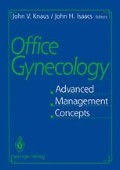Abstract
Abnormal uterine bleeding occurs in women of any age. Pregnancy, infection, various birth control methods, endocrine abnormalities, neoplasm, blood dyscrasias, and systemic diseases are all part of the differential diagnosis of this abnormality. In the premenopausal woman, pregnancy-related disorders, infection, and birth control methods are the most common factors. In the perimenopausal years, abnormal bleeding often occurs due to perimenopausal ovarian dysfunction. In the postmenopausal woman, neoplasm must be excluded.
Access this chapter
Tax calculation will be finalised at checkout
Purchases are for personal use only
Preview
Unable to display preview. Download preview PDF.
References
Coulter A, Bradlow J, Agass M, Martin-Bates C, Tulloch A. Outcomes of referrals to gynecology outpatient clinics for menstrual problems: an audit of general practice records. Br J Obstet Gynaecol 1991; 98: 789–796.
Kempers RD. Dysfunctional uterine bleeding. In: Gynecology and Obstetrics. New York: JB Lippincott Company, 1991.
Meldrum DR. Perimenopausal menstrual problems. Clin Obstet Gynecol 1983, 26: 762–768.
Fraser IS, McCarron G, Markham R. A preliminary study of factors influencing perception of menstrual blood loss volume. Am J Obstet Gynecol. 1984; 149: 788–793.
Speroff L, Glass RH, Kase NG. Clinical Gynecologic Endocrinology and Infertility. Baltimore, Md: Williams & Wilkins, 1989.
Pedersen AB, Bartholomew MJ, Dolence LA, Aljadir LP, Netteburg KL, Lloyd T. Menstrual differences due to vegetarian and nonvegetarian diets. Am J Clin Nutr. 1991; 53: 878–885.
Brown S, Vessey M, Stratton I. The influence of method of contraception and cigarette smoking on menstrual patterns. Br J Obstet Gynaecol. 1988; 95: 905–910.
Beitins IZ, McArthur JW, Turnbull BA, Skrinar GS, Bullen BA. Exercise induces two types of human luteal dysfunction: confirmation by urinary free progesterone. J Clin Endocrinol Metab. 1991; 72: 1350–1358.
Loucks AB. Effects of exercise training on the menstrual cycle: existence and mechanisms. Med Sei Sports Exerc. 1990; 22: 275–280.
Rulin MC, Davidson AR, Philliben SG, Graves WL, Cushman LF. Changes in menstrual symptoms among sterilized and comparison women: a prospective study. Obstet Gynecol. 1989; 74: 149–154.
Grimes, DA. Diagnostic dilation and curettage: a reappraisal. Am J Obstet Gynecol. 1982; 142: 1–6.
DiSaia PJ, Creasman WT. Clinical Gynecologic Oncology. St. Louis, Mo: CV Mosby Company, 1989.
Nesse RE. Abnormal vaginal bleeding in perimenopausal women. Am Fam Physician. 1989; 40: 185–192.
Hall P, Maclachlan N, Thorn N, et al. Control of menorrhagia by the cyclo-oxygenase inhibitors naproxen sodium and mefenamic acid. Br J Obster Gynaecol. 1987; 94: 554.
DeCherney AH, Diamond MD, Lavy G, Polan ML. Endometrial ablation for intractable uterine bleeding: hysteroscopic resection. Obstet Gynecol. 1987; 70: 668.
Magos AL, Baumann R, Lockwood GM, Turnbull AC. Experience with the first 250 endometrial resections for menorrhagia. Lancet. 1991; 337: 1074–1078.
Scommegna A, Dmowski WP. Dysfunctional uterine bleeding. Clin Obstet Gynecol. 1973; 16: 221–254.
Editor information
Editors and Affiliations
Rights and permissions
Copyright information
© 1993 Springer-Verlag New York, Inc.
About this chapter
Cite this chapter
Kirschner, C.V. (1993). Abnormal Uterine Bleeding. In: Knaus, J.V., Isaacs, J.H. (eds) Office Gynecology. Springer, New York, NY. https://doi.org/10.1007/978-1-4612-4340-3_4
Download citation
DOI: https://doi.org/10.1007/978-1-4612-4340-3_4
Publisher Name: Springer, New York, NY
Print ISBN: 978-1-4612-8740-7
Online ISBN: 978-1-4612-4340-3
eBook Packages: Springer Book Archive

